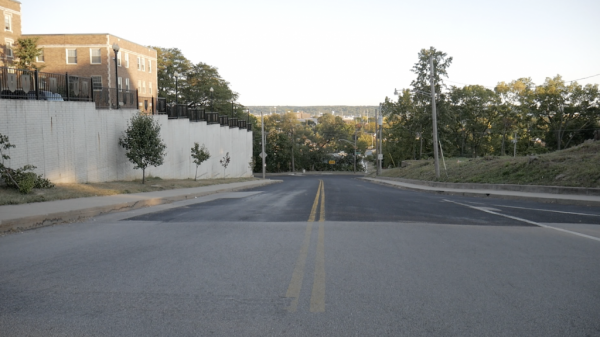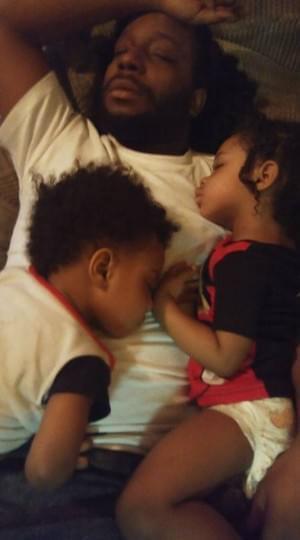‘Down The Hill:’ Violence Often Rooted In Inequality

A look down "the hill" on the south side of Peoria. Brandon Towns/for Illinois Newsroom
For many families and young adults living in Peoria’s South Side, gun violence is too often a part of life and something they’ve been fighting against — with few resources.
Part of the challenge, according to researchers, is getting the broader community to examine a part of itself and confront the barriers that keep families, predominantly minorities, from moving out of poverty.
Peoria’s South Side neighborhood presents an unusual case because part of the isolation has to do with its geography. It’s located at the bottom of a hill.
“Never Forget”
That hill is wedged between the locations of a two unrelated shootings that took place last month in Peoria. They also happened on the same weekend, just hours apart.
The first, on Apr. 7, took place in the South Side. At 9:15pm, Peoria police responded to a call near the 2700 block of W. Wyoming. They arrived to find John W. Bell III, a 24-year-old black man, lying dead in the street. An autopsy found ten bullet wounds.
About five hours later, at 1:45am, officers responded to the second incident. They were called to a house, three blocks away from Bradley University. Two victims, Nasjay Murry, 18, and Anthony Polnitz, 22, who are also African American, were shot and killed while at a house party. Murry was a freshman at the private university.
For a city that typically sees less than 20 homicides per year, three shooting deaths in a weekend was enough for local media to declare it the “the bloodiest stretch of violence” Peoria had witnessed in years.
“While there’s gun violence in Peoria on a regular basis, there hasn’t been something this close to campus that’s affected our student body,” Margaret LeJeun, a professor, said.
Friends and classmates put up a memorial with balloons and cards outside the home, where the two young people died. Three days later, police identified and arrested a suspect in the shooting.
Of the two weekend homicides, the one near Bradley got significantly more public attention and outcry. This could be due in part to the superlative nature of the incident, the university says it was the first killing of a student in the school’s history.
But violence is traumatizing to all communities, not just in places where it’s a rare occurrence.
The chief of the Peoria Police Department made a similar point during a press conference following the shootings.
Chief Loren Marion III told reporters gathered at the meeting not to forget that another young person was killed that weekend, referring to John Bell III.
Until this story, no details about Bell’s life have been published. Only his name, age and time of death. Police have yet to identify a suspect in the case.
“I feel like the police make a separation. Everybody feels the same loss, but on the bottom of the hill, they’re not as worried as much, because it’s going to continue to happen even if they solve the murder,” Sarah Figgers, Bell’s girlfriend, said.
The “hill” she’s referring to is a literal hill, where Peoria’s South Side is situated at the bottom.
“It’s not just my boyfriend. All these young black men are getting killed, and it’s like there’s nothing happening in consequence to it,” Figgers said.
She and Bell would be celebrating their fifth anniversary together this September. They have two kids, ages 2 and 3. Those who know him best called him “Jay B.”

John Bell III was killed on Apr. 7, during a bloody weekend in Peoria. Sarah Figgers, his girlfriend of five years, says he loved staying home with his kids, Jaiden and Serenity.
“It’s going to be hard for his family and for everybody knew him and who loved him. It’s a major loss,” Figgers said, through tears.
Peoria Public Schools says Bell worked as a bus monitor in the district for two years, and based on his record, he was a good employee. Figgers says Bell was about to take a new job as a mail carrier. In his free time, he also wrote and recorded hip hop music. His most recent song is about losing his own father. It’s called “Never Forget.”
Figgers says her last memory of Bell is the night he died. He was leaving to visit his friend’s house. Moments after he walked out the door, Figgers says, Bell ran back inside to tell her “I love you” and to kiss his two babies goodnight.
The next time she saw her partner, he was being placed inside a body bag. Figgers immediately recognized his dreadlocks and his jacket. She says officers at the crime scene asked whether Bell had a criminal record — because his name didn’t appear in their database.
“It hurt a lot because my boyfriend has never been in the back of a police car, let alone gotten a ticket,” Figgers said.
Peoria Police would only say the department has yet to identify a suspect. The case remains open and under investigation. A redacted police report obtained through a Freedom of Information Act request shows that one officer at the scene performed CPR on Bell.
Figgers says family members, especially his mother, have made repeated calls to the department, but they’re losing hope about the case being solved.
“Down the Hill”
Peoria is a small city of about 114,000 people, yet what’s striking is the magnitude of economic and racial separation. An often-cited report put out by the online news site 24/7 Wall Street in 2016 ranked Peoria as the worst city in the nation for black people to live, based on measures, like income and employment.
Sociologists from the University of Chicago have found that concentrated disadvantages in communities directly correlate to increases in violence. The South Side in Peoria is one case of how structural inequalities and segregation — racial and socioeconomic — have resulted in higher incidences of shootings and homicides.
Economically, the majority African-American neighborhood is considered one of the 100 poorest zip codes in the US, with 45 percent of its residents living below the poverty level. The median household income is $21,852, compared to $54,860 for the Peoria metro area.
Violence in Peoria, like in other cities, isn’t isolated to one part of town. The South Side is a striking case because the segregation is seen and felt in the layout of the city. Again, it’s situated at the bottom of a hill. That hill is often used metaphorically by locals, for instance the expression, “get over the hill.”
“For a long while that was considered you making it because you got off the end here,” Peoria native and business owner Steve Winters said.
At the top of the hill sits the affluent, mostly white, Moss-Bradley neighborhood. It’s a stretch of decadent architecture and park-like manicured lawns and gardens. Bradley students can be seen walking to class and jogging along the historic manors.
Winters, who owns a barbershop located at the bottom of “the hill,” says the expression is also used colloquially as a way to classify people. He says he was considered an “up-the-hill” kid, because he grew up on the North Side of town.
“That’s the dichotomy in Peoria, the up-the-hill kids are kinda like the rich black folks that made it,” Winters said. “That’s neither here nor there. Do you think the police look at your license and say ‘oh, he’s an up-the-hill black kid?’, hell no. You’re just a black kid.”
The “hill” terminology bothers Winters less than the negative perceptions about the South Side neighborhood, where he’s been a successful business owner for 25 years. He says television crews only seem to visit to cover shootings. He says one time, he even slammed his door in a reporter’s face.
On Bradley’s campus, known as “the hilltop,” university students say they’ve been warned not to go down the hill. Many students I spoke with say they’d heard the warning by faculty or classmates. A spokesperson for Bradley says the phrase “down the hill” is not used in any official capacity.
Dylan Bull, a senior told me on his way home from class that he’d heard warnings not to go South of the hill, during his time at Bradley.
“We’re normally just told to stay on campus and to stay around the hilltop because the neighborhoods around us aren’t the best conditions right now,” Bull said. When asked whether he’d been to the neighborhoods himself, he said no.
Another BU senior, Sheanee Dham had a more nuanced take. She’s from Chicago, where she says she grew up with similar perceptions about her own neighborhood.
“I would never think twice about going down the hill, I mean I know I’ve heard of incidents that have happened down there, but I’ve also heard of incidents that have happened up in North Peoria as well,” Dham said.
All of this context matters for understanding why certain areas are more affected by gun violence than others. The hill separates these two communities, where the one at the top is predominantly white and prosperous. For kids who grow up at “the bottom,” being acutely aware of these perceptions and their surroundings come with direct social-emotional costs.
“Kids internalize the context in which they’re living. They look out and they see what kinds of opportunities the people around them have,” Dr. Deborah Gorman-Smith, interim dean of the School of Social Administration at the University of Chicago, said.
Gorman-Smith is one of the leading researchers on the higher burden of gun violence in low-income, urban communities, primarily in Chicago. Her studies were cited in the latest federal spending bill, which included funding for trauma-informed care. In addition to physical indicators, like blight and unstable housing, she said youth are keenly perceptive of what opportunities are visible around them.
“It absolutely starts to change the way you think about your future and what the possible options might be,” Gorman-Smith said. “When I talk to youth, they don’t think about planning five years ahead. They’re really planning for the next few months or wondering if they’re going to live to be 18.”
South Side “Alumni”
The number of residents who call the South Side home has dropped to less than half of what it was 50 years ago, from nearly 33,000 in 1970 to less than 15,000 today.
That exodus of residents left hundreds of vacant properties, a weakened housing market and less commercial investment.
Rita Ali is one of those who fled the neighborhood. Reluctantly, she adds.
“I decided to move because of the level of burglaries that was taking place, increases in crime. My neighborhood was starting to change.”
Ali, who grew up in the 60s and 70s, remembers a South Side that was safer, more connected. There were grocery stores, an ice skating rink, and things to do on the weekends. She says all of that is gone.
Ali says she noticed things started to shift in the late nineties. She was playing outside with her granddaughter.
“And a car went down the street, and it was just random shots that fired out,” Ali said. “And i thought, i love my neighborhood, I love the south side, but i’m going to move.”
That moment wedged her out of the community where she grew up, went to high school and got her first summer job. Now, she lives almost as far North as you can drive and still be in Peoria.
Rita Ali may not live in South Side, but she still has family there, and she’s a strong advocate for her old neighborhood.
“I would say despite all of the negative, there’s still that determination to make things better,” Ali said. “There’s still that determination to say, you know, this is my community. And i think, we all have to reclaim it.”
Ali says what the area needs most is investment, in particular, more housing and commercial properties. That’s why she and other city leaders are spearheading an effort to get former residents – called “South Side alumni” — to invest in vacant lots for development.
Family Bonds Aren’t Bulletproof
The Irby family is a striking contrast to the majority of families who left the neighborhood. Around the time Rita Ali moved away from the South Side, Abigail Irby and her kids moved in.
Every Sunday, the Irby family gathers in the kitchen – aunts, uncles, and nine grandchildren – like they do every weekend. The stove is crowded with casserole dishes full of family favorites, like meatloaf or neck bones and spaghetti.
Abigail Irby, considered the matriarch of this close-knit family, moved to her home on Peoria’s South Side about 20 years ago, but it wasn’t her idea. She lived in another part of town until a friend, whom she describes as ‘a prominent woman,’ offered her a deal on a property.
“And she said I was a good home keeper. I kept my home up, so she felt that if I moved to the South End of town and live in the neighborhood, I can also help build,” Irby said.
So Irby packed up her three kids and moved, to what she calls “the deep” South Side, despite the growing concerns about gang violence in the area.
“My kids were not pleased with me moving on down to the South Side. Because kids being kids, they were looking at it from a different perspective than I was,” Irby said. “I told my kids we were being used to be an example for the people around us, to show them a better way of living.”
The Irby kids enjoyed growing up on the South Side. Irby established a reputation as the neighborhood watchdog and matriarch. She says her children were part of the “AK — Abby’s Kids — Gang,” which meant they stayed out of trouble. At least that was her intent.
“But then I don’t want to say my son got involved with the wrong people, but the wrong people became his friends. People became jealous of him,” Irby said. “He was the manager of Bob Evans.”
She says, on several occasions, her son James Anthony Irby got robbed after cashing his paycheck.

Abigail Irby (left) and her two adult children took a trip to the aquarium, shortly before her son James Anthony (center) was killed during a home invasion in 2013. Also pictured: Jushawnda Dunigan, and Anthony’s girlfriend KeiAmber Beard, who was also shot and killed, along with their unborn child. Police never identified a suspect in the shooting.
For Abigail Irby and her family, every moment is a reminder of the consequences of gun violence. In 2013, Abigail’s son, James Anthony Irby was shot and killed, during an apparent home invasion, in another part of town. He was 29, and at home with his girlfriend, KeiAmber Beard, who was also killed, along with their unborn child.
Police never identified a suspect. Five years later, his death still devastates the family. James Irby left behind two kids, a son and a daughter.
Abigail is determined to live out her mission in the neighborhood. She volunteers at a community center for kids after school. And even though she sometimes hears gunshots at night, she’s determined to stay on the South Side, as she says, “where God put me.”
Supporting Families
These stories are snapshots of what research and data tell us about gun violence. Poor communities of color are suffering disproportionately. Homicides are the leading cause of death for African-American youth between the ages of 10-24.
But the shootings aren’t isolated to a single part of town, as the Bradley community witnessed last month. Gun violence also destroys families, even ones who appear to be doing all the right things.
“The large majority of parents and families are doing the exact same things that I do with my kids,” Gorman-Smith, from the University of Chicago said. “And we are expecting the most from families in contexts where they are the least-resourced to be able to do that.”
Gorman-Smith says it takes more than good parenting to be successful in contexts where there are fewer people and services to help. She and her colleagues are developing and monitoring several evidence-based interventions to combat violence in some of Chicago’s high-risk neighborhoods. Gorman-Smith says some of the most significant improvements she’s seen happen when parents and families have added social support networks, like a village.
In the Bronzeville neighborhood, Bright Star and the University of Chicago are working with churches, social service agencies, politicians, schools, and hospitals to pool together resources and collaborate on addressing four key areas: community development, trauma-informed care, education and workforce development.
Rita Ali says addressing those areas in Peoria would help reduce the racial and socioeconomic disparities in the South Side neighborhood.
“We can’t just leave the people there alone to solve the problems that are taking place there,” Ali said. “We have to embrace the South Side.”

Illinois Newsroom is a regional journalism collaboration focused on expanding coverage of education, state politics, health, and the environment. The collaborative includes Illinois Public Media in Urbana, NPR Illinois in Springfield, WSIU in Carbondale, WVIK in the Quad Cities, Tri States Public Radio in Macomb, Harvest Public Media and the Midwest Center for Investigative Reporting. Funding comes from the stations and grants from the Corporation for Public Broadcasting (CPB) and McCormick Foundation.
Links
- Suicide A Driver Of Gun Deaths In Rural America
- How Gun Violence Is Traumatizing Kids And What Schools Can Do About It
- Police Data Show Gun Violence A Chronic, Growing Problem Across Illinois
- C-U Area Students Host Town Hall On Gun Violence
- Town Hall Panelists Brainstorm Ways To Curb Gun Violence in Champaign-Urbana
- Victims Of Gun Violence Pay A Lifelong Price
- Summer Gun Violence: A Look Toward Solutions; ‘Hate Has No Home Here’ Campaign

